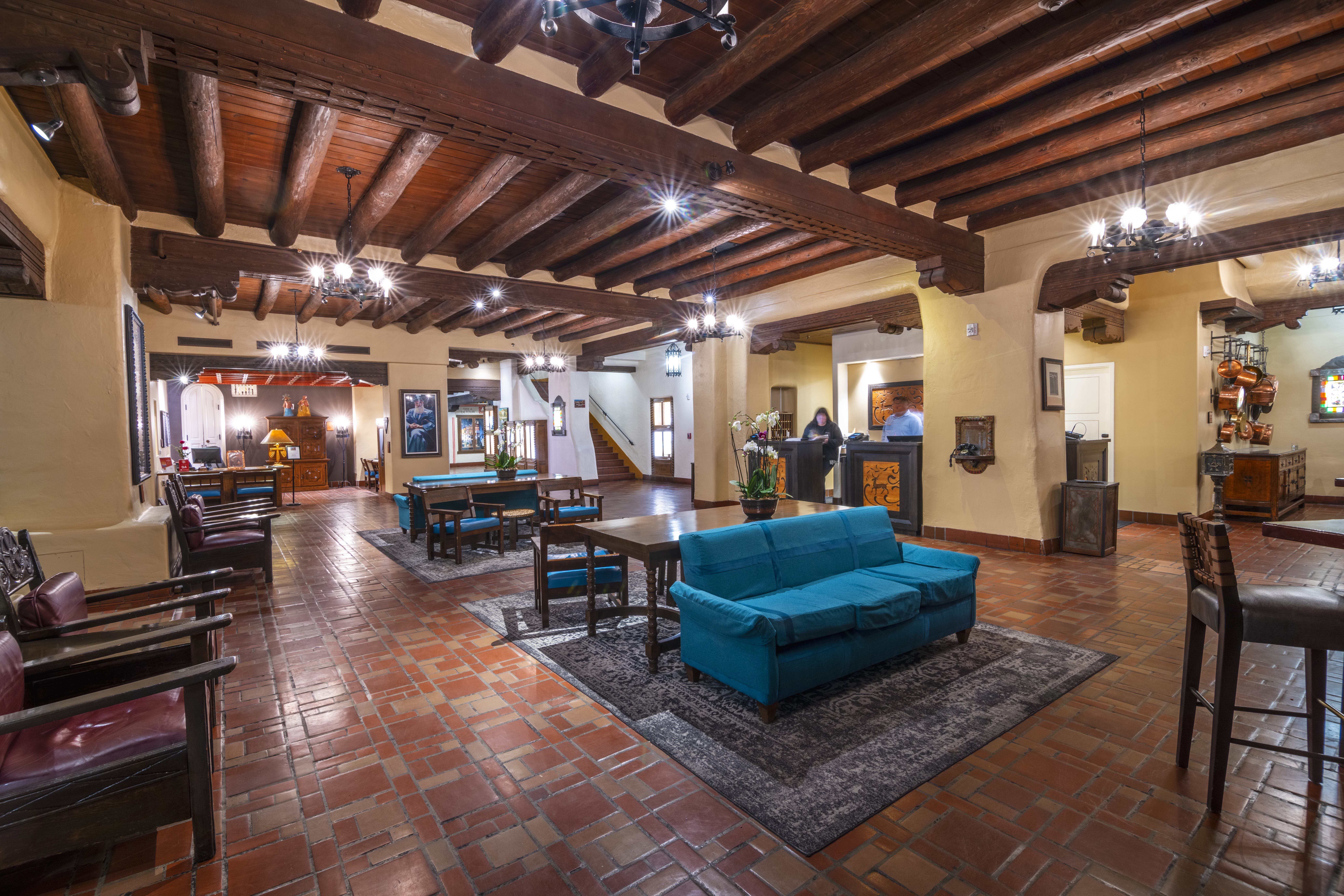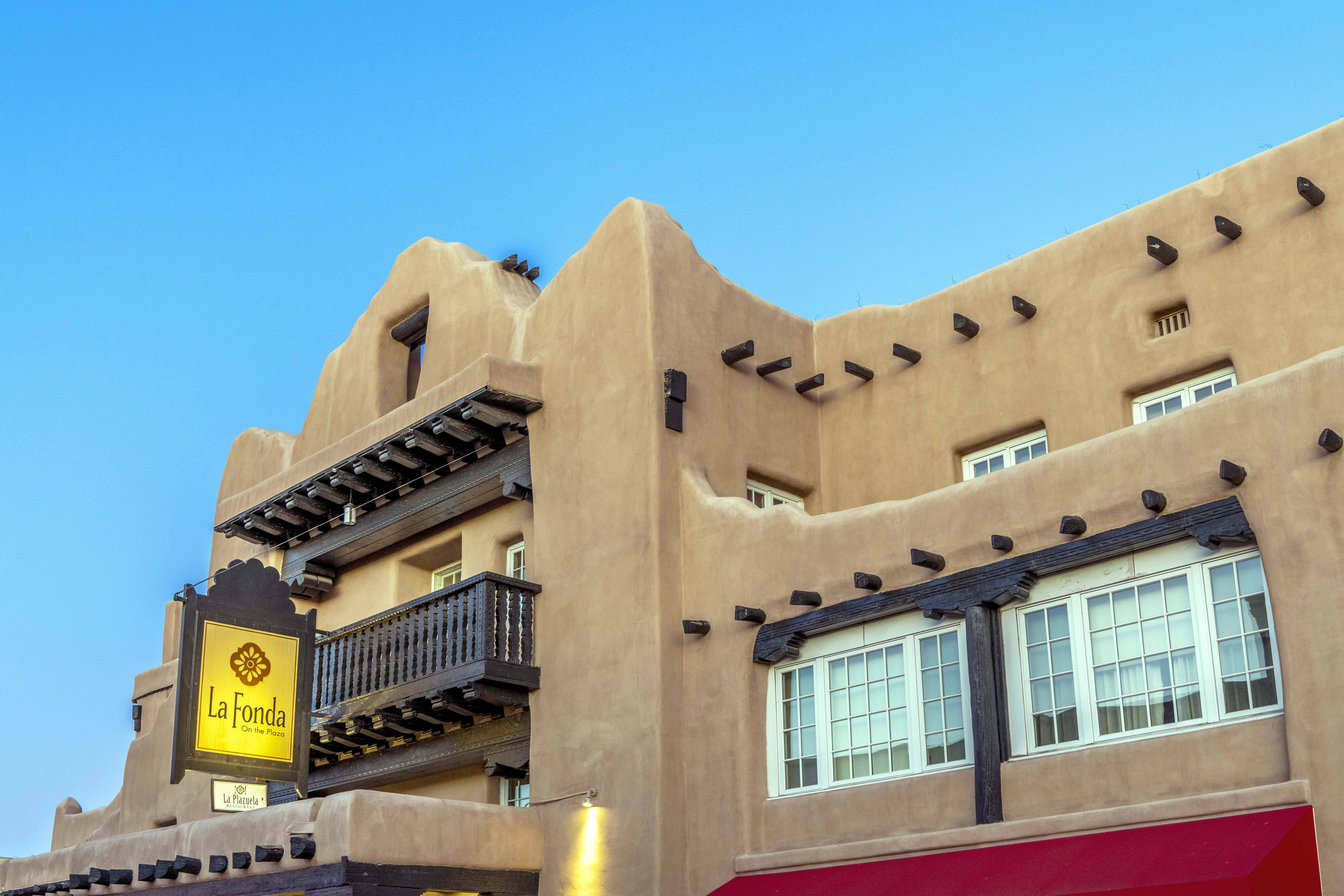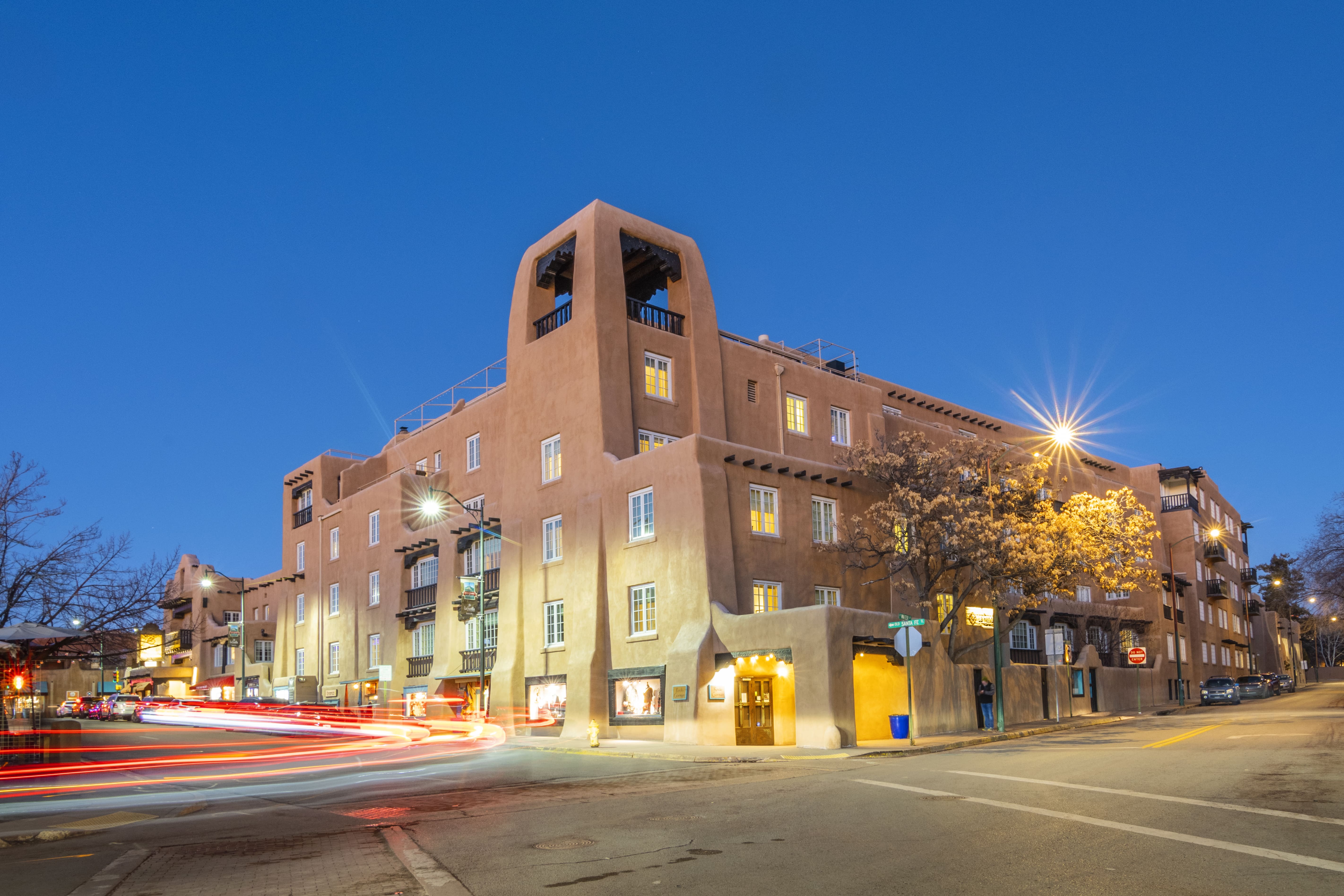In Santa Fe, New Mexico, a huge complex the color of warm desert sand occupies a large and prominent corner in the city’s Old Town. If it weren’t so constantly filled with activity, and if it weren’t so immaculately maintained, it might look as if it had sat there for hundreds of years, an adobe emergence out of the timelessness of the Southwestern desert. In truth, it has now stood there for 100 years, while other adobe creations preceded it on this spot for nearly three additional centuries.
A dozen or so years before the Mayflower arrived in 1620 on the East Coast of what would become America, a rudimentary inn on a dusty street corner welcomed travelers. And so, La Fonda’s story really begins 400 years ago, at this gathering place in what would become the capital city of the State of New Mexico.
In 1922, the vestiges of earlier inns and outbuildings on that simple intersection were replaced by a new and larger hotel. But by 1928, the Fred Harvey Company was in charge of the lodging and utilized the considerable talents of the legendary designer Mary Colter and a young architect named John Gaw Meem to completely remodel and expand the hotel into the massive adobe structure with a southwestern elegance that still occupies a full city block.
Through good times and bad, through the decline of the railroad passenger years and the arrival of Route 66, this building has stood sentinel on this corner as the only hotel on Santa Fe’s historic plaza. Its tower reaching toward the turquoise sky, this La Fonda has welcomed guests for a hundred years, and all throughout 2022, La Fonda on the Plaza has celebrated its century and its story.
Inn at the End of the Trail
Santa Fe was established in 1607 by Spaniards, and somewhere around that time, an inn or “fonda” was already operating on the very corner where the lovely La Fonda on the Plaza stands today. North American travelers stopped at the inn over the next two centuries as they passed through Santa Fe along the El Camino Real de Tierra Adentro.
In 1821, Captain William Becknell organized a trading party from Franklin, Missouri, across the Great Plains to New Mexico. The party stayed at the inn in Santa Fe for a month, trading their goods at a profit before making the return trip to Missouri. A second trading party in 1822 explored variations of their original route and blazed the Santa Fe Trail. Military movement and pioneer traffic followed, and Santa Fe’s early lodging on the corner became known as the “Inn at the End of the Trail.” Soldiers, trappers, gamblers, gold seekers, and politicians sought out lodging here throughout the rest of the 19th Century as national events such as the Civil War and railroad expansion touched what would become the State of New Mexico in 1912.
A Hundred Years Ago
As the 1900s began, a one-story lodging known as the Exchange Hotel or simply the “Fonda Americana” occupied that corner. The inn had served as a community gathering place and had hosted travelers of all sorts. Here, grand balls had been held and travelers had found food, beverage, and rest. Of course, if one believes all the tales, Billy the Kid had not only washed dishes in the kitchen but played piano in the hotel’s bar, someone was hanged in the courtyard, and another unfortunate soul or two were shot in the lobby. A well-documented story tells of territorial council member William Rynerson shooting and killing Chief Justice John Slough in an altercation in the bar. All this history crumbled in 1919 when a World War I tank on a Victory Loan tour was allowed to assist in the demolition of the old lodging to make way for a newer, larger, and more luxurious hotel.
“The Exchange Hotel sat on this very corner, built in the 1830s. Then in 1919, a group of Santa Fe citizens formed the Santa Fe Building Corporation. Locals could buy shares to invest in building the new hotel, in order to raise $200,000,” said Ed Pulsifer, Director of Sales and historian and tour coordinator at La Fonda. “Rapp and Hendrickson out of Trinidad [Colorado] were the architects. The hotel struggled the first couple of years it was open and then went into receivership.”
Harvey, Colter, and Meem Rebuild
But in 1925, the Atchison, Topeka & Santa Fe (AT&SF) purchased La Fonda, and in 1926, the Fred Harvey Company leased it, which was unique for Harvey because La Fonda was not a trackside hotel.
“Two things happened in 1926 that had a major impact on Santa Fe and a major impact on this hotel. In May 1926, the Indian Detours [tourism cars to the pueblos] launched, and in November 1926, Route 66 opened — right behind the hotel. So, between those two things happening, people were coming into this sweet, sleepy little town to the hotel that was in bankruptcy,” Pulsifer explained.
The original alignment of Route 66 cut through the heart of Santa Fe bringing with it a surge in tourism numbers. But with not enough hotel rooms in Santa Fe to cater to the increased travel traffic, La Fonda’s sudden success necessitated renovations and expansion. Under Fred Harvey this involved the design talents of Mary Colter and the fresh architectural approach of a young John Gaw Meem. When Colter and Meem were recruited, Colter was nearing 60 years old and was a 30-year veteran of the Fred Harvey Company, while Meem had only been a practicing architect in Santa Fe since 1924. But by 1928, when they began the project, Meem had become adept at balancing his respect for vernacular architecture with new design, uniquely qualifying him to work on La Fonda with Colter.
While Meem remodeled and expanded La Fonda with additional rooms and suites for contemporary use, ever mindful of the historic nature of the building, Colter executed a total interior redesign. As was her signature by then, she struck an inspirational balance between Spanish and Southwest Native American esthetics, including such design elements as Mexican tiles and exposed vigas and featuring the work of several Santa Fe artists, including the famed Native American muralist and painter Olive Rush.
La Fonda reopened in May 1929, and for decades, the guest book read like a Who’s Who list of politicians, celebrities, and prominent people from all stripes, including Eleanor Roosevelt, John F. Kennedy, Errol Flynn, James Stewart, Clint Eastwood, Diane Keaton, and, during the World War II era, the scientists working on the then-top-secret Manhattan Project in Los Alamos. La Fonda had “arrived” and was renowned around the world.

Fall and Rise and Fall
Then came the age when petroleum, automobiles, and fast highways ruled, and the Harvey hotels associated with railroad travel were failing. It was an age that saw more than one of legendary architect Mary Colter’s hotels sink into nonentity, such as Albuquerque’s Alvarado Hotel razed in 1970, just 65 miles southwest of La Fonda.
Meanwhile, over in Texas lived a couple from New York City who had made it big in the Texas oil market — Sam and Ethel Ballen. Sam and Ethel had happily adapted to life in the American Southwest. Intrigued by Southwestern native art and design, they ended up making multiple trips to Santa Fe, which they loved. By unanimous family vote, in 1967 they moved to Santa Fe. And in serendipitous fashion, the following year, the Fred Harvey Company put a rundown and neglected La Fonda up for sale. And Sam and Ellen purchased it.
“They knew that this hotel was too special to let it be torn down, so they bought it in 1968 and it was in absolutely horrible condition. The Harvey company, at the end, just did not take care of it. And literally for the next 40 years, Sam and Ethel Ballen just put their heart and soul into bringing the hotel back to life,” explained Pulsifer, who is proud of his 37 years in the hospitality industry, but even prouder of his 20 years at La Fonda. “They would do trades with [upcoming local] artists for room and board, and we have a lot of their work throughout the hotel. They just kept improving the hotel. And so many employees have been here for 30 to 40 years.”
The Ballen’s zest for life knew no bounds, and they traveled the world, visited friends, and climbed mountains. Their support of numerous causes in their beloved adopted home of Santa Fe along with the generous loan of their hotel facilities endeared them to the community. Advancing age didn’t slow them down until Ethel died from a massive stroke in 2006 and Sam followed a year later, dying after a fall while shoveling snow.
“They [Sam and Ethel] had five daughters, who ran the hotel, but they decided that they just didn’t want to be in the hotel business anymore, you know, the reminders of their parents,” Pulsifer said.
By then, it was time for renovations again.

Passing the Torch
Meanwhile, Texan Jenny Kimball — who also loved the Santa Fe area, just like her family friends, the Ballens, did — had been literally on the scene since the late 1980s.
“I moved to Santa Fe in the late ‘80s and lived with Sam and Ethel Ballen, who owned the hotel since ‘68, while I studied for the New Mexico bar exam, because I was licensed in Texas. Why not New Mexico?” explained Jenny Kimball, Chairman of the Board for La Fonda. “What drew me was our friendship with the Ballens, as well as I’m a real outdoor advocate and lover, and like to bike, snow ski and horseback ride, and hike. Growing up and living in Dallas, Texas, you pretty much had to get on a plane to go do that. And so, I decided after practicing law in Dallas for a couple of years, that I wanted to try small town living in an area that was more conducive to my real passions, which was the outdoors. I called the Ballens and said, ‘I want to come.’ And we came out as a family because the Ballens had been friends with my parents.”
Kimball began practicing law in New Mexico after passing the state bar exam, and she began doing legal work for La Fonda. She also bought some stock in the hotel under the Ballens’ tenure, thereby becoming one of the owners. As she spent more time at La Fonda and the Ballens aged, with their daughters helping to run the hotel, it was assumed that Jenny would take over at some point.
“They had kind of teed me up and asked me if when they pass, I would take over. And so, it was just out of a sense of duty and appreciation and protection for the Ballens to make sure that the hotel was run by an honest, ethical person who would honor their ownership. I kind of got the baton passed to me. I wasn’t in the hospitality business. It wasn’t my background or anything that I planned. It was really out of the personal connection to the family that owned the hotel.”
Kimball and her brother Phillip Wise, also an attorney, formed Cienda Partners, a small group of family investors, that realized that the hotel had always meant a lot to them over the years when traveling to Santa Fe. So, when the hotel sold on October 31, 2014, the partnership was ready to take on some major renovations, including all new electrical from the basement up, all new windows, and “the entire facility, which is a city block, re-stuccoed.”
With the hotel purchase came the responsibility for its art collection and the design sensibilities of the building itself, but Kimball already had a leg up. Or maybe two.
My dad was a lawyer, but my mom was a member of the Dallas American Institute of Architects (AIA), so we kind of grew up with architect friends in our home. And Sam [Ballen] had hired Barbara Felix, a female architect, just as an interior designer,” Kimball explained. “It was just so wonderful to be working with a professional, talented female, and Barbara did just what Ed [Pulsifer] did immediately, immersed herself in the history [of the hotel] and of Mary Jane Colter and John Gaw Meem, and really partnered with me on how to improve the infrastructure in a way that would thread the needle of the current, modern-day luxury standards, and still honor the history.”
Kimball also joined the board of directors of the Southwestern Association for Indian Arts (SWAIA), which the Ballens had also been involved with, that produces the annual Santa Fe Indian Market.
“I’m certainly not an expert but sitting on a board that’s putting on the largest Native American Art Market in the country, I learned a lot and met a lot of artists. I kind of just immersed myself, starting with Native American art,” Kimball added. Artwork from talented contemporary Native American artists adorns La Fonda’s interior spaces, thanks to Kimball’s immersion into the local art community.

Into the Next Century
It only takes a cursory bit of research to learn that La Fonda on the Plaza is a huge, world-famous success story. And a solid partnership seems prepared to sail this magical stucco-covered ship well into another century. But first, it was time in 2022 to celebrate reaching the hotel’s landmark status; and celebrate they did.
“In March, we held a Centennial Party that was phenomenal, with over 400 attendees, including the governor and the mayor — the Party of the Century is what we called it,” explained Britta Andersson, Director of Marketing. “And we created a documentary video that highlights the history of the hotel and a Centennial plaque.”
The La Fonda website was expanded to include a history timeline and a gallery of event photos, while the Centennial logo found its way into social media and marketing. A special gift for guests during the year has been an expandable accordion-fold set of images from over the decades. Detours at La Fonda, the hotel’s gift shop, has offered celebratory Centennial gift items.
“We also remodeled a portion of the hotel, which is above the parking garage. It’s 15 distinct luxury accommodations with their own concierge. It’s called the Terrace at La Fonda, and it offers gorgeous rooftop views of the cathedral or the Loretto Chapel or the mountains. It’s a great way to mark the future, while still honoring the past,” said Andersson.
Marking the future, honoring the past. La Fonda has gotten good at that, through all its iterations and regenerations. No one is in danger of forgetting this story while La Fonda and its current team of caretakers are telling it so well.
While dining on the patio, taking a docent-led tour of the property, shopping in its street-level shops, or perusing the hotel’s outstanding collection of over 1,200 pieces of art dating back to 1920, guests would probably agree with Ed Pulsifer when he says, “The world walks through this hotel. It’s one of the greatest historic properties, anywhere.”
